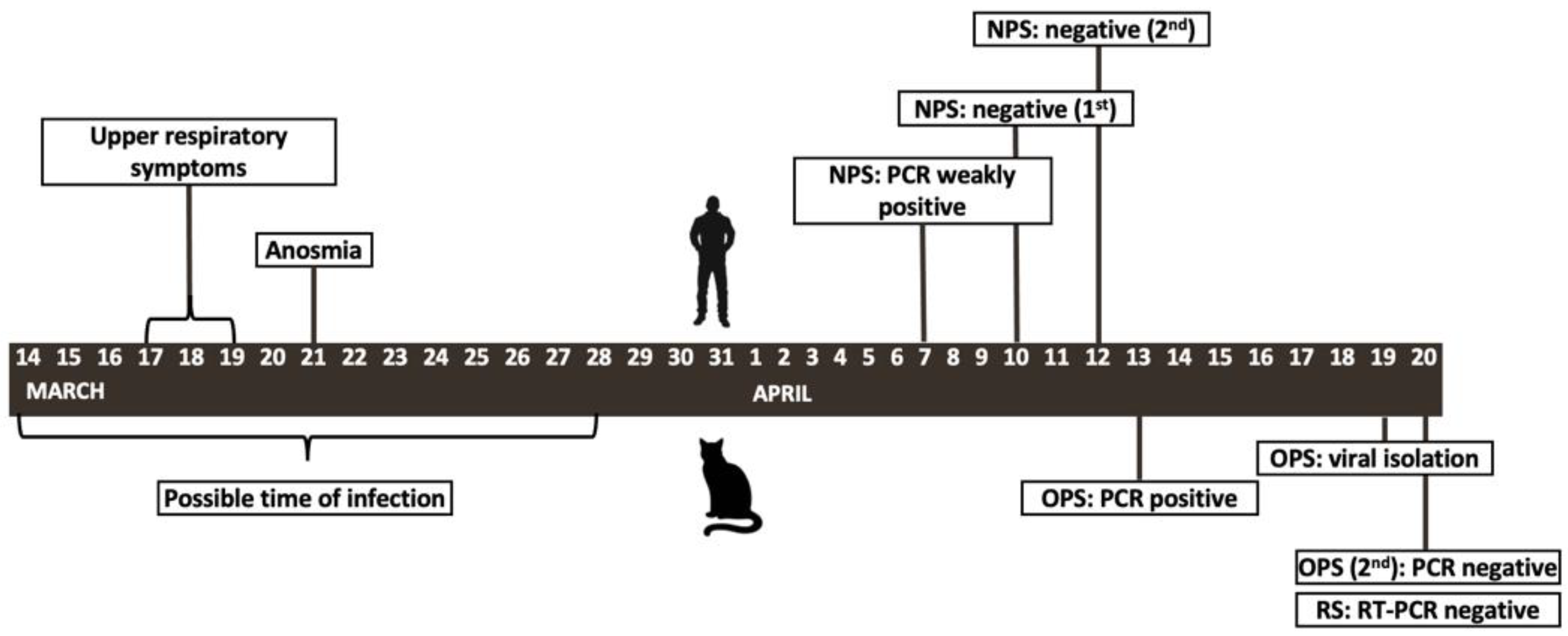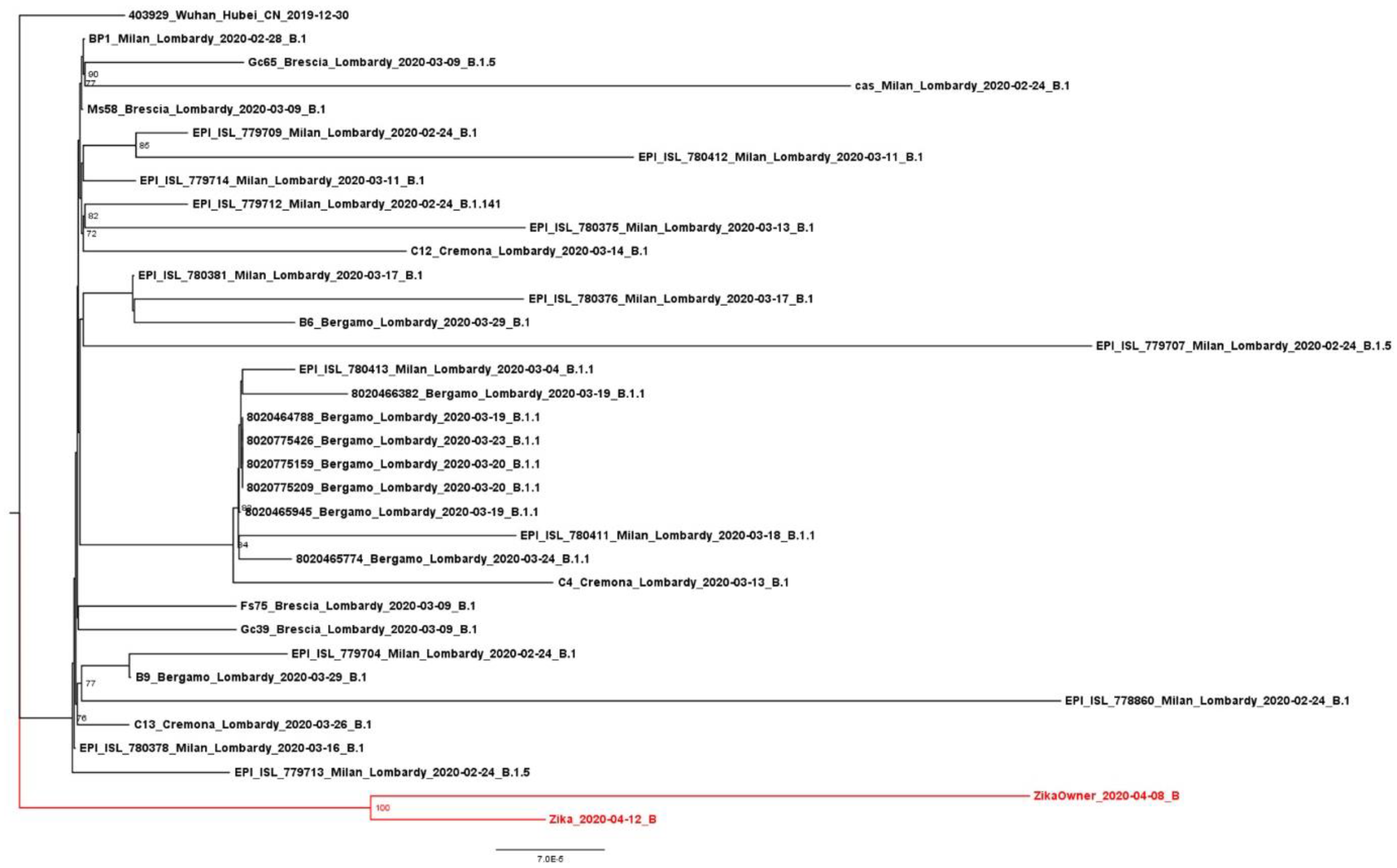Human-to-Cat SARS-CoV-2 Transmission: Case Report and Full-Genome Sequencing from an Infected Pet and Its Owner in Northern Italy
Abstract
:1. Introduction
2. Case Report and Virological Analyses
3. Discussion
Author Contributions
Funding
Institutional Review Board Statement
Informed Consent Statement
Data Availability Statement
Conflicts of Interest
References
- Decaro, N.; Lorusso, A. Novel human coronavirus (SARS-CoV-2): A lesson from animal coronaviruses. Vet Microbiol. 2020, 244, 108693. [Google Scholar] [CrossRef]
- Halfmann, P.J.; Hatta, M.; Chiba, S.; Maemura, T.; Fan, S.; Takeda, M.; Kinoshita, N.; Hattori, S.I.; Sakai-Tagawa, Y.; Iwatsuki-Horimoto, K.; et al. Transmission of SARS-CoV-2 in Domestic Cats. N. Engl. J. Med. 2020, 383, 592–594. [Google Scholar] [CrossRef]
- Oreshkova, N.; Molenaar, R.J.; Vreman, S.; Harders, F.; Munnink, B.B.O.; Hakze-van Der Honing, R.W.; Gerhards, N.; Tolsma, P.; Bouwstra, R.; Sikkema, R.S.; et al. SARS-CoV-2 infection in farmed minks, the Netherlands, April and May 2020. Euro. Surveill. 2020, 25, 2001005. [Google Scholar] [CrossRef]
- Oude, M.B.B.; Sikkema, R.S.; Nieuwenhuijse, D.F.; Molenaar, R.J.; Munger, E.; Molenkamp, R.; Spek, A.v.d.; Tolsma, P.; Rietveld, A.; Brouwer, M.; et al. Transmission of SARS-CoV-2 on mink farms between humans and mink and back to humans. Science. 2020, 371, 172–177. [Google Scholar] [CrossRef]
- Hammer, A.S.; Quaade, M.L.; Rasmussen, T.B.; Fonager, J.; Rasmussen, M.; Mundbjerg, K.; Lohse, L.; Strandbygaard, B.; Jørgensen, C.S.; Alfaro-Núñez, A.; et al. SARS-CoV-2 Transmission between Mink (Neovison vison) and Humans, Denmark. Emerg. Infect. Dis. 2020, 27, 547–551. [Google Scholar] [CrossRef] [PubMed]
- PRO/AH/EDR> COVID-19 Update (189): Netherlands (NB) Animal, Farmed Mink, Research, Cat, Dog Archive Number: 20200517.7344274. Available online: https://promedmail.org/promed-post/?id=20200517.7344274 (accessed on 10 February 2021).
- Decaro, N.; Balboni, A.; Bertolotti, L.; Martino, P.A.; Mazzei, M.; Mira, F.; Pagnini, U. SARS-CoV-2 infection in dogs and cats: Facts and speculations. Front. Vet. Sci. 2021. [Google Scholar] [CrossRef]
- Confirmation of COVID-19 in Two Pet Cats in New York|CDC Online Newsroom|CDC [Internet]. 2020. Available online: https://www.cdc.gov/media/releases/2020/s0422-covid-19-cats-NYC.html (accessed on 29 May 2020).
- Carlos, R.S.A.; Mariano, A.P.M.; Maciel, B.M.; Gadelha, S.R.; de Melo Silva, M.; Belitardo, E.M.M.A.; Rocha, D.J.P.G.; de Almeida, J.P.P.; Pacheco, L.G.C.; Aguiar, E.R.G.R.; et al. First genome sequencing of SARS-CoV-2 recovered from an infected cat and its owner in Latin America. Transbound. Emerg. Dis. 2021. [Google Scholar] [CrossRef] [PubMed]
- Sailleau, C.; Dumarest, M.; Vanhomwegen, J.; Delaplace, M.; Caro, V.; Kwasiborski, A.; Hourdel, V.; Chevaillier, P.; Barbarino, A.; Comtet, L.; et al. First detection and genome sequencing of SARS-CoV-2 in an infected cat in France. Transbound. Emerg. Dis. 2020, 67, 2324–2328. [Google Scholar] [CrossRef]
- Patterson, E.I.; Elia, G.; Grassi, A.; Giordano, A.; Desario, C.; Medardo, M.; Smith, S.L.; Anderson, E.R.; Prince, T.; Patterson, G.T.; et al. Evidence of exposure to SARS-CoV-2 in cats and dogs from households in Italy. Nat. Commun. 2020, 11, 6231. [Google Scholar] [CrossRef] [PubMed]
- Hemida, M.G.; Abduallah, M.M.B. The SARS-CoV-2 outbreak from a one health perspective. One Health 2020. Available online: https://www.ncbi.nlm.nih.gov/pmc/articles/PMC7102578/ (accessed on 29 May 2020). [CrossRef] [PubMed]
- Zehender, G.; Lai, A.; Bergna, A.; Meroni, L.; Riva, A.; Balotta, C.; Tarkowski, M.; Gabrieli, A.; Bernacchia, D.; Rusconi, S.; et al. Genomic characterization and phylogenetic analysis of SARS-COV-2 in Italy. J. Med. Virol. 2020, 92, 1637–1640. [Google Scholar] [CrossRef] [PubMed] [Green Version]
- Zhang, Q.; Zhang, H.; Gao, J.; Huang, K.; Yang, Y.; Hui, X.; He, X.; Li, C.; Gong, W.; Zhang, Y.; et al. A serological survey of SARS-CoV-2 in cat in Wuhan. Emerg. Microbes. Infect. 2020, 9, 2013–2019. [Google Scholar] [CrossRef] [PubMed]
- Lai, A.; Bergna, A.; Caucci, S.; Clementi, N.; Vicenti, I.; Dragoni, F.; Cattelan, A.M.; Menzo, S.; Pan, A.; Callegaro, A.; et al. Molecular Tracing of SARS-CoV-2 in Italy in the First Three Months of the Epidemic. Viruses 2020, 12, 798. [Google Scholar] [CrossRef] [PubMed]
- Neira, V.; Brito, B.; Agüero, B.; Berrios, F.; Valdés, V.; Gutierrez, A.; Ariyama, N.; Espinoza, P.; Retamal, P.; Holmes, E.C.; et al. A household case evidences shorter shedding of SARS-CoV-2 in naturally infected cats compared to their human owners. Emerg. Microbes. Infect. 2020, 15, 1–22. [Google Scholar] [CrossRef] [PubMed]
- World Organization for Animal Health (OIE) COVID-19 Portal. Available online: https://www.oie.int/scientific-expertise/specific-information-and-recommendations/questions-and-answers-on-2019novel-coronavirus/ (accessed on 10 February 2021).


| Strain Name | Lineage | Clade | Gene | |||
|---|---|---|---|---|---|---|
| ORF1a | ORF1b | S | N | |||
| Zika_2020-04-12 | B | 19A | C357W,S1952L,D4344G | N1830S | D614G,P1213Q | S235Y |
| ZikaOwner_2020-04-08 | B | 19A | C357W,S1952L,K2446R,D4344G | T17N,T197A,S967P,I1766T,N1830S | V289I,D614G,P1213Q | V244D |
Publisher’s Note: MDPI stays neutral with regard to jurisdictional claims in published maps and institutional affiliations. |
© 2021 by the authors. Licensee MDPI, Basel, Switzerland. This article is an open access article distributed under the terms and conditions of the Creative Commons Attribution (CC BY) license (http://creativecommons.org/licenses/by/4.0/).
Share and Cite
Pagani, G.; Lai, A.; Bergna, A.; Rizzo, A.; Stranieri, A.; Giordano, A.; Paltrinieri, S.; Lelli, D.; Decaro, N.; Rusconi, S.; et al. Human-to-Cat SARS-CoV-2 Transmission: Case Report and Full-Genome Sequencing from an Infected Pet and Its Owner in Northern Italy. Pathogens 2021, 10, 252. https://doi.org/10.3390/pathogens10020252
Pagani G, Lai A, Bergna A, Rizzo A, Stranieri A, Giordano A, Paltrinieri S, Lelli D, Decaro N, Rusconi S, et al. Human-to-Cat SARS-CoV-2 Transmission: Case Report and Full-Genome Sequencing from an Infected Pet and Its Owner in Northern Italy. Pathogens. 2021; 10(2):252. https://doi.org/10.3390/pathogens10020252
Chicago/Turabian StylePagani, Gabriele, Alessia Lai, Annalisa Bergna, Alberto Rizzo, Angelica Stranieri, Alessia Giordano, Saverio Paltrinieri, Davide Lelli, Nicola Decaro, Stefano Rusconi, and et al. 2021. "Human-to-Cat SARS-CoV-2 Transmission: Case Report and Full-Genome Sequencing from an Infected Pet and Its Owner in Northern Italy" Pathogens 10, no. 2: 252. https://doi.org/10.3390/pathogens10020252
APA StylePagani, G., Lai, A., Bergna, A., Rizzo, A., Stranieri, A., Giordano, A., Paltrinieri, S., Lelli, D., Decaro, N., Rusconi, S., Gismondo, M. R., Antinori, S., Lauzi, S., Galli, M., & Zehender, G. (2021). Human-to-Cat SARS-CoV-2 Transmission: Case Report and Full-Genome Sequencing from an Infected Pet and Its Owner in Northern Italy. Pathogens, 10(2), 252. https://doi.org/10.3390/pathogens10020252









